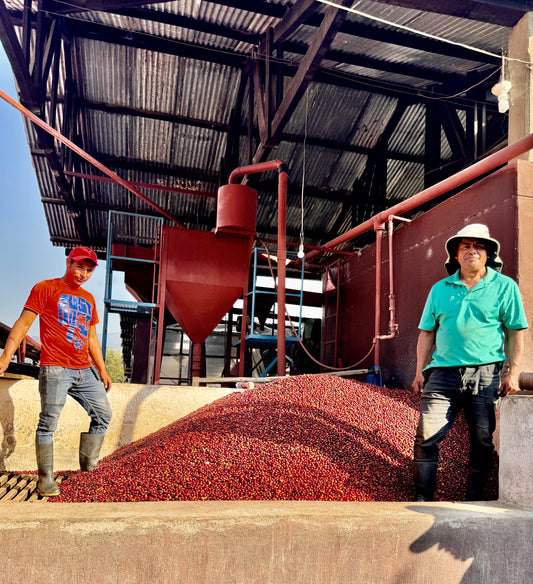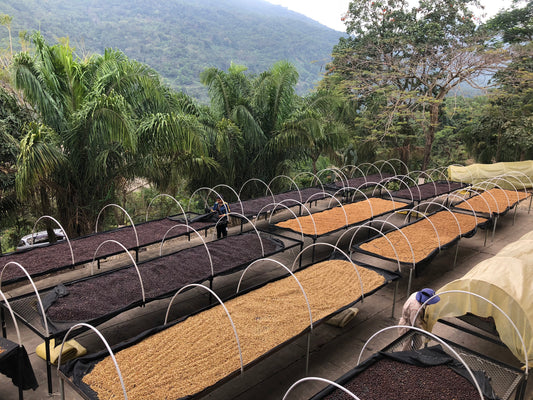Coffee Cupping at Home: How to Identify Tasting Notes

Coffee Cupping (or tasting) at home is easy to do and a lot of fun. When on the lookout for specialty coffee, it’s common to see tasting notes like “floral” or “citrus” written on the bag. But when you go to try the coffee yourself, and all you taste is coffee, it can be discouraging. It can make you feel like you’re just not naturally inclined to picking up flavour notes. What we want to show you, is how you can identify tasting notes in your favorite coffee.

The truth is, tasting coffee is a skill that you acquire over time, and it requires you to develop a flavour palette. As a beginner, the best way to do this is a coffee cupping session at home.
But don’t worry–this isn’t a test. You don’t need to pull out an official coffee cupping score sheet and mathematically evaluate each coffee. Coffee cupping at home is meant to be fun, and it’s a great place to start when it comes to identifying tasting notes.
Before we show you how to do a cupping session, we’ll answer some common questions. We’ll go over the flavour categories that you’re assessing, the list of tools you’ll need, and the type of coffee to use.
What is coffee cupping?
Coffee cupping is when you brew several different coffees at once and taste them all separately, recording your findings. The brewing is done quite simply by pouring hot water directly over the grounds in a cup. The coffee is sipped with a cupping spoon to assess flavour.
Coffee cupping is an industry practise normally conducted by coffee importers to gauge coffee quality. Each coffee receives a score out of 100. By definition, specialty coffee is coffee that receives at least 80 points out of 100.
Cupping is also done by roasters as a form of quality control, or by coffee shops when they’re choosing coffees to put on their menu.
Our previous blog about coffee cupping is based around the SCAA cupping form, but this guide will teach you how to do it at home. While you’ll be focusing on identifying flavours, you won’t need the SCAA sheet (phew!).
What’s the point of coffee cupping at home?
Cupping at home lets you try a whole variety of coffees at once. Trying them out side-by-side gives you a reference point, helping you spot the differences between them. This will help you develop your flavour palette.
Though there are many other factors determining flavour, every coffee origin has its own characteristic flavour notes. Trying out single origin coffees from different regions is a great place to start when identifying flavour notes.
Coffee cupping is also fun for budding coffee enthusiasts. It’s especially fun to do with a small group of friends. Because you need a few different varieties of coffee to do a home cupping session, you can send your friends home with the leftover coffee that didn’t get brewed.
What am I looking for when cupping coffee?
When doing your coffee cupping session, you’ll want to record your findings on a sheet of paper. Let’s say you want to try 4 coffees. Make 4 columns on your sheet of paper. Write the name or origin of the coffee, and a line for the following categories.
- Aroma (smell): simply write down your first impression of the aroma of the dry grounds and the brewed coffee. If you’re new to coffee, you might not know what to write here. That’s okay–there’s no wrong answer.
- Flavour: this is the immediate first impressions you get from tasting the coffee. Maybe it hits you in the face with lemon, lime, and orange. Or maybe, it’s rich and slightly bitter, like dark chocolate.
- Cleanliness: this refers to the absence of unpleasant flavours or defects. Unpleasant flavours can be vegetal, fermenty, cardboard-like, and overly earthy. A clean cup lets pleasant flavour notes shine through.
- Aftertaste: what do you taste after it leaves your tongue? Does the flavour change? Is there a lingering sweetness? Does the flavour linger, or does it dissipate quickly?
- Acidity: does the flavour give your tongue a sour feeling, like a crisp green apple, or does it lack acidity? Note: acidity refers to flavour, not pH balance. There’s a difference between sour, poorly brewed coffee and coffee with a natural acidity profile.
- Body: body refers to the strength of the flavour. Some coffees, like coffees out of Brazil, will have a light or thin body. Other coffees will have a heavy, rich body. Body is similar to aftertaste: a light-bodied coffee will have less of an aftertaste, whereas a full-bodied coffee will linger.
- Sweetness: sweetness on the tongue can be similar to acidity. Does it have a bright taste, reminding you of fruit or sugar? Or does it have little sweetness, with a darker flavour?
What if I don’t have words to describe the coffee?
When you’re stumped for words, you can always consult this interactive flavour wheel. It’s not cheating to read up on all the ways a coffee can taste. Rather, it gives you a vocabulary to describe what a coffee reminds you of. It’ll help you in the future when you encounter challenging coffees.
What do I need for coffee cupping at home?
Here’s the list of supplies and ingredients you’ll need for a successful home coffee cupping session.
- 4 bowls (small sugar bowls work best)
- Weight scale
- Burr grinder
- Freshly ground coffee (ie. ground within the last 15 minutes)
- Kettle (any kettle will do)
- Boiled water
- 2-8 cupping spoons (a soup spoon or any large spoon will do)
- A cup with clean water (for rinsing your spoon between tastings)
- Your coffee cupping sheet
What coffee should I use?
For coffee cupping at home, we recommend trying at least 4 types of coffee with different flavour notes. Great options include Ethiopia Guji Uraga, Bolivia Buena Vista, Kenya Kiambu AA, and Costa Rica El Poeta.
What ratio is best for coffee cupping?
For coffee cupping, you’ll want a weaker ratio than a pour over. The pour over ratio is 1:16, but you’ll want a 1:17 ratio (1 part coffee, 17 parts water). So, if you’re using 12 grams of coffee, you’ll need 200 mL of water. Weaker ratios help you identify tasting notes better.

Ready to start cupping coffee? Let’s go!
How to cup coffee at home
- Measure out 12 grams each of the different types of coffee. Be careful to purge the grinder between varieties to avoid mixing coffees. Place the grounds into 4 separate bowls.
- Smell the dry grounds, and record your findings.
- Pour hot water (30-60 seconds off the boil) directly up to the top of the bowls, making sure to saturate all the grounds. Set a timer for 4 minutes, and let the bowls sit.
- After 4 minutes, the grounds will have floated to the top. Smell the wet aroma, and record your findings.
- Break the crust by using a spoon to stir the grounds and let them sink to the bottom. This stops the brewing process. Use two spoons to catch the remaining grounds floating on top, and rinse your spoons. After you’ve broken the crust, the coffee will still be very hot. Wait an additional 10 minutes.
- Once it’s cooled to the point of being drinkable, grab your sheet of paper and pencil, and it’s time to start evaluating the coffee. Take a spoonful of the coffee, and audibly slurp it to spray it across your mouth. This helps you assess all aspects of the flavour.
-
Write your findings under each heading: flavour, cleanliness, aftertaste, acidity, body, and sweetness. Do this for each type of coffee until you’re done.

Not your average cup of joe
Congratulations on your first coffee cupping! We hope you found the experience fun. You may have liked some of the coffees more than others, and you may have even disliked some of them. This is all normal–everyone has their own personal taste. Hopefully, you now have a better idea of what flavours you like best.
Cupping coffee at home is simply an exercise of curiosity. Developing your flavour palette takes time, and you have to drink many coffees before you start to notice patterns. Once you’re familiar with tasting notes, you’ll enjoy coffee so much more going forward. Rather than treating coffee like a caffeine fix, you’ll start to treat it with a sense of wonder.
We hope your coffee cupping journey brings you joy and intellectual stimulation. May your cup runneth over!
Want to learn more about the ins and outs of specialty coffee? Check out our article on how to read a coffee label like a pro!









